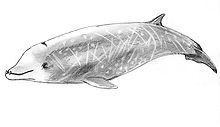- Cuvier's beaked whale
-
Cuvier's beaked whale 

Size comparison against an average human Conservation status Scientific classification 
Kingdom: Animalia Phylum: Chordata Class: Mammalia Order: Cetacea Family: Ziphiidae Subfamily: Ziphiinae Genus: Ziphius
G. Cuvier, 1823Binomial name Ziphius cavirostris Cuvier's beaked whale range Cuvier's beaked whale (Ziphius cavirostris)[1] is the most widely distributed of all the beaked whales. It is the only member of the genus Ziphius. Another common name for the species is goose-beaked whale because its head is said to be shaped like the beak of a goose. Georges Cuvier first described it in 1823 from part of a skull found in France in 1804. He thought it represented an extinct species — it wasn't until the 1870s that it was realized the type specimen represented a living species.[2]
Contents
Physical description
Cuvier's beaked whale has a short beak in comparison with other species in its family, with a slightly bulbous melon. The melon is white or creamy in color and a white strip runs back to the dorsal fin about two-thirds of the way along the back. The rest of the body color varies by individual: some are dark grey; others a reddish-brown. Individuals commonly have white scars and patches caused by cookiecutter sharks. The dorsal fin varies in shape from triangular to highly falcate. The fluke of the whale is about one-quarter the body length. The whale grows up to about 7 meters (23 ft) in length and weighs 2–3 tonnes (2.0–3.0 long tons; 2.2–3.3 short tons). They live for forty years.
The Cuvier's beaked whale is difficult to distinguish from many of the mesoplodont whales at sea.
Food and foraging
Cuvier's beaked whale feeds on several species of squid, including those in the families Cranchiidae, Onychoteuthidae, Brachioteuthidae, Enoploteuthidae, Octopoteuthidae and Histioteuthidae; they also prey on deep-sea fish.[3]
Range and habitat
Cuvier's has a cosmopolitan distribution in deep, offshore waters from the tropics to the cool temperate seas. In the North Pacific, it occurs as far north as the Aleutians and in the North Atlantic as far north as Massachusetts in the west to the Shetlands in the east. In the Southern Hemisphere, it occurs as far south as Tierra del Fuego, South Africa, southern Australia, New Zealand, and the Chatham Islands. It also frequents such inland bodies of waters as the Gulfs of Mexico and California and probably also the Caribbean and Mediterranean Seas.[4]
Cuvier’s beaked whale may be one of the most common and abundant of the beaked whales, with a worldwide population likely well over 100,000. There are estimated to be about 80,000 in the eastern tropical Pacific, nearly 1,900 off the west coast of the United States (excluding Alaska), and over 15,000 off Hawaii. [5]
Conservation
Japanese whalers in the past opportunistically caught Cuvier's, taking between 3 and 35 each year (before 1955).[5] The species has been reported taken incidentally in fisheries in Colombia, the Italian swordfish fishery, and in the drift gillnet fishery off the U.S. west coast, where between 22 and 44 individuals died each year off California and Oregon from 1992 to 1995.[5]
Beaked whales may also be sensitive to noise. A higher incidence of strandings has been recorded in noisy seas such as the Mediterranean. Multiple mass strandings (beachings) have occurred following operations by the Spanish Navy.[6]
Specimens
- MNZ MM002092, collected Cape Kidnappers, Hawkes Bay, New Zealand, 14 October 1988.
References
- ^ Ziphius cavirostris Cuvier's Beaked Whale at marinebio.org
- ^ Sharks and Whales (Carwardine et al. 2002), p. 354.
- ^ Evans, Peter G. H. 1987. The Natural History of Whales and Dolphins. Facts on File Publications, New York, p. 137.
- ^ Reeves, R., Stewart, B., Clapham, P. & Powell, J. (2002). Guide to Marine Mammals of the World. New York: A.A. Knopf. p. 255. ISBN 0-375-41141-0.
- ^ a b c Taylor, B.L., Baird, R., Barlow, J., Dawson, S.M., Ford, J., Mead, J.G., Notarbartolo di Sciara, G., Wade, P. & Pitman, R.L. (2008). Ziphius cavirostris. In: IUCN 2008. IUCN Red List of Threatened Species. Downloaded on 26 February 2009. Database entry includes justification for why this species is listed as least concern.
- ^ Beached whale#SONAR
- Cuvier's Beaked Whale in the Encyclopedia of Marine Mammals Thomas A. Jefferson, 1998. ISBN 0-12-551340-2
- National Audubon Society Guide to Marine Mammals of the World Reeves et al., 2002. ISBN 0-375-41141-0.
- Whales, Dolphins and Porpoises Carwardine, 1995. ISBN 0-7513-2781-6
In the news
- Cuvier's beaked whale found on a beach on Mull, West Scotland (BBC)
- Cuvier's beaked whale images, text in French
- Whale that dived record 6,230ft and held breath for 85 minutes, (timesonline.co.uk)
- Cuvier's beaked whale skull found on the west coast of the peloponnese , text in Greek
- Remains of rare whale to be studied(Maui News)
External links
- Whale & Dolphin Conservation Society (WDCS)
- Cuvier's Beaked Whale - The Beaked Whale Resource
- Cuvier's Beaked Whale - ARKive bio
Categories:- IUCN Red List least concern species
- Toothed whales
- Ziphiids
- Mammals of Europe
- Fauna of the Indian Ocean
- Fauna of Southeast Asia
- Cetaceans of Thailand
- Cetaceans of Australia
- Monotypic mammal genera
- Marine mammals of Hawaii
- Animals described in 1823
Wikimedia Foundation. 2010.


